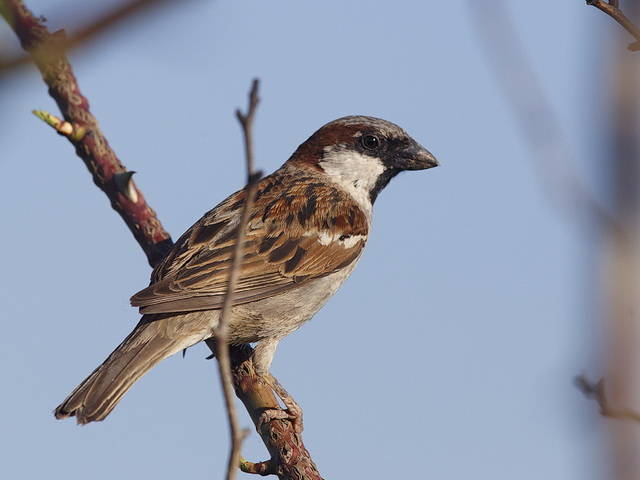
The male of the Indian Sparrow has the grey crown and rump; dark mottled on the head. The uppertail and sometimes the neck are olive-grey. The mantle is bright chestnut-brown with black longitudinal strips. The lore and narrow eye-strip are black. Behind the eyes and on the flanks of the head there are the broad chestnut strips which can to connect on the neck. The cheeks and adjacent parts of the head and neck are all white; rare light-grey tinged. The chin, throat, craw and top of the breast are black. The underparts are white, flanks are grayish. The lesser wing coverts are chestnut; the median coverts are dark-brown with white tips; and the greater ones are black-brown with broad clayey edges. The flight feathers are dark-brown with light-clayey edges, the speculum on the greater coverts is light-pale almost white. The tail feathers are brownish with the narrow light edges. The bill is black, the legs and claws are dark-brown. The female has buffy-grey crown, neck, rump and uppertail; sometimes dark mottled on the head. The supercilium is light-buffy, the cheeks are grayish. The mantle with black strips; the light strips formed by the outer webs are clayey. The throat, craw and breast are buffy-grey; sometimes the chin and throat are dark-grey. Other underparts are white grey tinged on the flanks. The lesser wing coverts are olive-buffy; median coverts are blackish-brown with narrow light tips; greater ones and flight feathers are dark-brownish with clayey edges. The bill is dark-brown lightening on the base of lower mandible; the legs and claws are light-brown. Juveniles are similar on female. Weight 21,0-29,5 grams, wing - 65-84, tail 42-60 mm.
The Indian Sparrow is common, in places numerous breeding migrant. The main difference from House Sparrow that the Indian Sparrow in Kazakhstan is a seasonal migrant whereas the House Sparrow is resident bird. It inhabits the shrub thickets, forest-belts, gardens, groves, clay precipices, villages and stock-yards; often close to water and cereal fields; on the plains and altitudes up to 1300-2000 m. At the rest time it visits the stubble fields, reed-beds, kitchen gardens, grape plantations, riparian forest and thickets of tall weeds. It arrives from the early April till the beginning of May in flocks of 10-100 birds, later migrates in the mixed flocks together with Spanish Sparrow and Scarlet Rosefinch. Latest migrants caught at Chokpak Pass in the end of May. Breeds in colonies (sometimes with the Spanish Sparrow) numbered up to several hundred pairs. The sphere-shaped nest with the round branch entrance the Indian Sparrow builds in the trees, bushes, in the precipice holes, inhabited raptor nests or in the cavities of human constructions; from the green or dry grass, hay and straw; nest is lined with plentiful hair and feathers, but not always. At first the male begins to build the nest, later the female joins this work. Clutches of 5-10, usually 6 eggs in early May - early June, female incubates for 11-12 days. Both parents feed juveniles, which fledge at 12-13 days old, in early June - end July. One brooded. During the molting the Indian Sparrow lives in reed beds and bush thickets. The autumn migration begins in August, majority of the birds migrate in September, latest birds recorded in early November.
Gavrilov E. I., Gavrilov A. E. "The Birds of Kazakhstan". Almaty, 2005. "Птицы Казахстана" том 5. "Наука". Алма-Ата, 1974. Э.И.Гаврилов. "Фауна и распространение птиц Казахстана". Алматы, 1999.